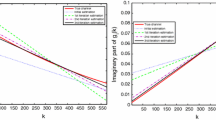Abstract
B. Steiner estimator used in the time-division synchronous code-division multiple access (TD-SCDMA) system is a low cost estimator. The precision of the estimated channel impulse responses (CIRs) is affected by noises in the channel, which result in worse performance of the estimation. For the reason that there are many threshold processing algorithms based on Steiner algorithm, the optimal threshold value becomes a crucial factor. In this paper, based on statistical information of channel in the data field, an improved channel estimation algorithm is proposed by detecting energy of CIR’s tap in time-domain, and the amplitude of estimated channel impulse response is adjusted by a gain coefficient. Simulation results prove the validity of the proposed technique for channel estimation good performance. Additionally, it is shown that the improved estimators outperform traditional channel estimators.










Similar content being viewed by others
References
Liu, G., Zhang, J., Zhang, P., Wang, Y., Liu, X., & Li, S. (2006). Evolution map from TD-SCDMA to future B3G TDD. IEEE Communications Magazine, 44(3), 54–61.
Peng, M., Wang, W., & Chen, H. H. (2010). TD-SCDMA evolution. IEEE Vehicular Technology Magazine, 5(2), 28–41.
Song, X., Li, K., & Hu, A. (2007). Two-stage channel estimation algorithm for TD-SCDMA system employing multi-cell joint detection. Circuits, Systems and Signal Processing, 26(6), 76–80.
Shaoli, K., Zhengding, Q., & Shihe, L.I. (2002). Improvement of the low-cost channel estimation method used in TD-SCDMA system. Journal of China Institution of Communications, 23(10).
Physical Channels and Mapping of Transports Channels Onto Physical Channels (TDD). (2002). 3rd generation partnership project (3GPP) technical specification group radio access network 3GPP TS 25.221, Rev. 4.7.
Spreading and Modulation (TDD). (2002). 3rd generation partnership project (3GPP) technical specification.
See, C. S., Cowan, C. F. N., & Nehorai, A. (1999). Spatiotemporal channel identification and equalization in the presence of strong co-channel interference. Signal Processing, 78, 127–138.
Steiner, B., & Baier, P. (1993). Low cost channel estimation in the uplink receiver of CDMA mobile radio systems [J]. Frequenz, 47(12), 292–298.
Steiner, B., & Jung, P. (1994). Optimum and suboptimum channel estimation for the uplink of CDMA mobile radio systems with joint detection [J]. European Transactions on Telecommunications, 5(1), 39–50.
KANG, S.-L., Qiu, Z.-D., & Li, S.-H. (2002). Improvement of the low-cost channel estimation method used in TD-SCDMA system [J]. Journal on Communications, 23(10), 108–113.
Yong-yu, Chang, Li-li, Huang, & Da-cheng, Yang. (2005). Performance analysis improvement of the channel estimation algorithm in the TD-SCDMA system [J]. Journal of Electronics and Information Technology, 27(7), 1110–1113.
Hou, J., Tang, L. (2010). An improved channel estimation algorithm of TD-SCDMA system. Critical Infrastructure (CRIS), 5th International Conference. 20–22, pp:1–5.
Frank, A. D., & Wolfang, U. (2005). Pilot-assisted channel estimation based on second-order statistics. IEEE Transactions on Signal Processing, 53(3), 1178–1193.
Wu, J. X., Xiao, C. S., & Letaief, K. B. (2005). Multiuser channel estimation for CDMA systems over frequency-selective fading channels. IEEE Transactions on Wireless Communications, 4(4), 1724–1736.
Marzook, A. K., Ismail, A., Ali, B. M., Sali, A., & Khatun, S. (2013). Singular value decomposition rank-deficient-based estimators in TD-SCDMA systems. Circuits, Systems, and Signal Processing, 32(1), 205–221.
Marzook, Ali K., Ismail, A., Ali, B. M., Sali, A., & Khatun, S. (2013). Reduced rank technique for joint channel estimationand joint data detection in TD-SCDMA systems. Wireless Personal Communication, 69, 1629–1646.
Cao, W., Yu, X., & Wang, W. (2004). A novel channel estimation algorithm with PN training sequence in TD-SCDMA systems. Communications, Circuits and Systems, 2, 847–850.
Song, X., Li, K. (2008). Improved channel estimation algorithm based on parallel interference cancellation. Neural Networks and Signal Processing, p. 466.
3GPP TS 25.221, V7.4.0. (2007). Physical channels and mapping of transport channels onto physical channels (TDD).
Klein, A., Kaleh, G. W., & Baier, P. W. (1996). Zero forcing and minimum mean-square-error equalization for multiuser detection in code-division multiple-access channels. IEEE Transactions on Vehicular Technology, 45(2), 276–287.
Guo-song, Li, & Zheng-OU, Zhou. (2005). An algorithm to reduce MSE of LS channel estimation in mobile OFDM system. Journal of Electronics Information Technology, 27(9), 1454–1458.
Xuan, Lu. (1998). Mathematical statistics foundation. Beijing: Tsinghua University Press.
Sun, Xiaoliang. (2010). Research on channel estimation based on training sequence in TD-SCDMA system. postgraduate dissertation Beijing University of Posts and Telecommunications.
Acknowledgments
The authors would like to acknowledge the anonymous reviewers for their thorough review and constructive suggestions, which significantly helped to improve the quality of the manuscript.
Author information
Authors and Affiliations
Corresponding author
Rights and permissions
About this article
Cite this article
Fan, T., Huang, S., Sun, Y. et al. An Improved Channel Estimation in a TD-SCDMA System Based on the Threshold of Detect Energy and its Performance Analysis. Wireless Pers Commun 82, 1773–1787 (2015). https://doi.org/10.1007/s11277-015-2312-7
Published:
Issue Date:
DOI: https://doi.org/10.1007/s11277-015-2312-7




